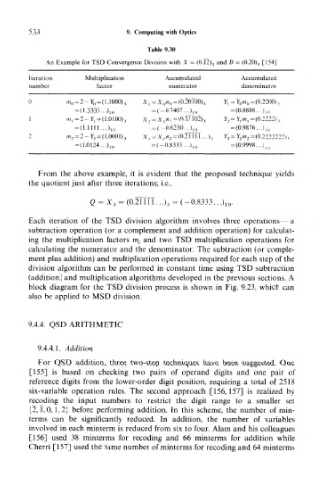Page 549 - Introduction to Information Optics
P. 549
534 9. Computing with Optics
Table 9.30
An Example for TSD Convergence Division with X = (0.12), and D = (0.20) 3 [154]
Iteration Multiplication Accumulated Accumulated
number factor numerator denominator
0 wi 0 = 2 - y o = (1.1000) 3 X, = X 0 m () - (0.20TOO) 3
= ( 1.3333... ) 10 = (-0.7407.. .), 0 _
1 m, = 2- y, =(1.0100) 3 A", = Jt,m, =(0.2TT02) 3
= (1.1111...),„ = (-0.8230. :.),o
2 m 2 = 2-y 2 = (1.0001) 3 A' 3 = X 2 m
=(-0.8333.
= (1.0124...) 10
From the above example, it is evident that the proposed technique yields
the quotient just after three iterations; i.e.,
Q = X 3= (0.2TlTT...) 3 = (-0.8333... ) 10-
Each iteration of the TSD division algorithm involves three operations— a
subtraction operation (or a complement and addition operation) for calculat-
ing the multiplication factors m t and two TSD multiplication operations for
calculating the numerator and the denominator. The subtraction (or comple-
ment plus addition) and multiplication operations required for each step of the
division algorithm can be performed in constant time using TSD subtraction
(addition) and multiplication algorithms developed in the previous sections. A
block diagram for the TSD division process is shown in Fig. 9.23, which can
also be applied to MSD division.
9.4.4. QSD ARITHMETIC
9.4.4.1. Addition
For QSD addition, three two-step techniques have been suggested. One
[155] is based on checking two pairs of operand digits and one pair of
reference digits from the lower-order digit position, requiring a total of 2518
six-variable operation rules. The second approach [156,157] is realized by
receding the input numbers to restrict the digit range to a smaller set
{2,1,0,1,2} before performing addition. In this scheme, the number of min-
terms can be significantly reduced. In addition, the number of variables
involved in each minterm is reduced from six to four. Alam and his colleagues
[156] used 38 minterms for recoding and 66 minterms for addition while
Cherri [157] used the same number of minterms for recoding and 64 minterms

